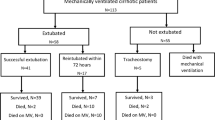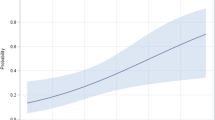Abstract
Objective
It is not known whether the poor outcome of ventilated cirrhotic patients is related to the severity of the underlying liver disease or to the severity of the acute illness for which ICU care is required. This study examines parameters both of chronic liver disease and of acute illness with regard to their influence on outcome in mechanically ventilated cirrhotic patients.
Design and setting
Retrospective observational case series in a 9-bed medical ICU in an academic tertiary care center.
Patients and measurements
Seventy-six consecutive cirrhotic patients who received mechanical ventilation were identified. Clinical and laboratory parameters were compared between ICU survivors and ICU deaths.
Results
There were 45/76 (59%) patients who died during their ICU stay. By univariate analysis, the Child-Pugh score, its components (serum bilirubin, prothrombin time), ALT, creatinine concentration, a clinical suspicion of infection, and the APACHE II score, but not the acute physiology score (APS), differed significantly between ICU survivors and ICU non-survivors. The Child-Pugh score was highly correlated to ICU mortality both in logistic regression analysis and receiver-operating characteristics analysis. Conversely, markers of acute illness, in particular the APS component of the APACHE II score, did not predict ICU survival.
Conclusions
Markers of advanced chronic liver disease but not of the severity of acute illness are correlated to ICU outcome in ventilated cirrhotic patients. The outcome of advanced cases (Child-Pugh score of 12 and above) is poor.



Similar content being viewed by others
References
Schlichting P, Christensen E, Fauerholdt L, Poulsen H, Juhl E, Tygstrup N (1983) Main causes of death in cirrhosis. Scand J Gastroenterol 18:881–888
Goldfarb G, Nouel O, Poynard T, Rueff B (1983) Efficiency of respiratory assistance in cirrhotic patients with liver failure. Intensive Care Med 9:271–273
Lee KC, Chiang AA (1997) The outcome of terminal liver cirrhosis patients requiring mechanical ventilation. Chung Hua I Hsueh Tsa Chih (Taipei) 59:88–94
Moreau R, Hadengue A, Soupison T, Kirstetter P, Mamzer MF, Vanjak D, Vauquelin P, Assous M, Sicot C (1992) Septic shock in patients with cirrhosis: hemodynamic and metabolic characteristics and intensive care unit outcome. Crit Care Med 20:746–750
Shellman RG, Fulkerson WJ, DeLong E, Piantadosi CA (1988) Prognosis of patients with cirrhosis and chronic liver disease admitted to the medical intensive care unit. Crit Care Med 16:671–678
Castera L, Pauwels A, Levy VG (1996) Prognostic indicators in patients with liver cirrhosis admitted to an intensive care unit. Gastroenterol Clin Biol 20:263–268
Aggarwal A, Ong JP, Younossi ZM, Nelson DR, Hoffman-Hogg L, Arroliga AC (2001) Predictors of mortality and resource utilization in cirrhotic patients admitted to the medical ICU. Chest 119:1489–1497
Foreman MG, Mannino DM, Moss M (2003) Cirrhosis as a risk factor for sepsis and death: analysis of the National Hospital Discharge Survey. Chest 124:1016–1020
Niskanen M, Kari A, Nikki P, Iisalo E, Kaukinen L, Rauhala V, Saarela E (1994) Prediction of outcome from intensive care after gastroenterologic emergency. Acta Anaesthesiol Scand 38:587–593
Zauner CA, Apsner RC, Kranz A, Kramer L, Madl C, Schneider B, Schneeweiss B, Ratheiser K, Stockenhuber F, Lenz K (1996) Outcome prediction for patients with cirrhosis of the liver in a medical ICU: a comparison of the APACHE scores and liver-specific scoringsystems. Intensive Care Med 22:559–563
Lee H, Hawker FH, Selby W, McWilliam DB, Herkes RG (1992) Intensive care treatment of patients with bleeding esophageal varices: results, predictors of mortality, and predictors of the adult respiratory distress syndrome. Crit Care Med 20:1555–1563
Afessa B, Kubilis PS (2000) Upper gastrointestinal bleeding in patients with hepatic cirrhosis: clinical course and mortality prediction. Am J Gastroenterol 95:484–489
Zimmerman JE, Wagner DP, Seneff MG, Becker RB, Sun X, Knaus WA (1996) Intensive care unit admissions with cirrhosis: risk-stratifying patient groups and predicting individual survival. Hepatology 23:1393–1401
Kubicka S, Rudolph KL, Hanke M, Tietze MK, Tillmann HL, Trautwein C, Manns M (2000) Hepatocellular carcinoma in Germany: a retrospective epidemiological study from a low-endemic area. Liver 20:312–318
Knaus WA, Draper EA, Wagner DP, Zimmerman JE (1985) APACHE II: a severity of disease classification system. Crit Care Med 13:818–829
McNeil BJ, Keller E, Adelstein SJ (1975) Primer on certain elements of medical decision making. N Engl J Med 293:211–215
Hanley JA, McNeil BJ (1982) The meaning and use of the area under a receiver operating characteristic (ROC) curve. Radiology 143:29–36
Pugh RN, Murray-Lyon IM, Dawson JL, Pietroni MC, Williams R (1973) Transection of the oesophagus for bleeding oesophageal varices. Br J Surg 60:646–649
Civetta JM (1973) The inverse relationship between cost and survival. J Surg Res 14:265–269
Hanson LC, Danis M, Garrett JM, Mutran E (1996) Who decides? Physicians’ willingness to use life-sustaining treatment. Arch Intern Med 156:785-789
Hanson LC, Danis M, Lazorick S (1994) Emergency triage to intensive care: can we use prognosis and patient preferences? J Am Geriatr Soc 42:1277–1281
Bleichner G, Boulanger R, Squara P, Sollet JP, Parent A (1986) Frequency of infections in cirrhotic patients presenting with acute gastrointestinal haemorrhage. Br J Surg 73:724–726
Singh N, Gayowski T, Wagener MM, Marino IR (1998) Outcome of patients with cirrhosis requiring intensive care unit support: prospective assessment of predictors of mortality. J Gastroenterol 33:73–79
Krenn CG, Krafft P, Schaefer B, Pokorny H, Schneider B, Pinsky MR, Steltzer H (2000) Effects of positive end-expiratory pressure on hemodynamics and indocyanine green kinetics in patients after orthotopic liver transplantation. Crit Care Med 28:1760–1765
Aneman A, Eisenhofer G, Fandriks L, Olbe L, Dalenback J, Nitescu P, Friberg P (1999) Splanchnic circulation and regional sympathetic outflow during peroperative PEEP ventilation in humans. Br J Anaesth 82:838–842
Berendes E, Lippert G, Loick HM, Brussel T (1996) Effects of positive end-expiratory pressure ventilation on splanchnic oxygenation in humans. J Cardiothorac Vasc Anesth 10:598–602
Brienza N, Revelly JP, Ayuse T, Robotham JL (1995) Effects of PEEP on liver arterial and venous blood flows. Am J Respir Crit Care Med 152:504–510
Matuschak GM, Pinsky MR, Rogers RM (1987) Effects of positive end-expiratory pressure on hepatic blood flow and performance. J Appl Physiol 62:1377–1383
Hering R, Viehofer A, Zinserling J, Wrigge H, Kreyer S, Berg A, Minor T, Putensen C (2003) Effects of spontaneous breathing during airway pressure release ventilation on intestinal blood flow in experimental lung injury. Anesthesiology 99:1137–1144
Hering R, Peters D, Zinserling J, Wrigge H, von Spiegel T, Putensen C (2002) Effects of spontaneous breathing during airway pressure release ventilation on renal perfusion and function in patients with acute lung injury. Intensive Care Med 28:1426–1433. Epub 1422
Acknowledgements
This research was supported by a grant from Bonfor (O-107.0022) to C. Rabe.
Author information
Authors and Affiliations
Corresponding author
Rights and permissions
About this article
Cite this article
Rabe, C., Schmitz, V., Paashaus, M. et al. Does intubation really equal death in cirrhotic patients? Factors influencing outcome in patients with liver cirrhosis requiring mechanical ventilation. Intensive Care Med 30, 1564–1571 (2004). https://doi.org/10.1007/s00134-004-2346-x
Accepted:
Published:
Issue Date:
DOI: https://doi.org/10.1007/s00134-004-2346-x




